Wilhelm Simon and Carl Harlbig joined in 1869 to form the porcelain manufacturing company Simon & Halbig in Gräfenhayn, Germany (or Gräfenhain.) Their advertising listing in the 1906 German Ceramic Industry address book mentions they existed since 1869. They claimed their factory to be located at Bahnstation in Ohrdruf
Simon & Halbig Doll Marks
Simon & Halbig dolls usually have their names or the initials S&H incised on the back of the bisque head or the shoulderplate. Sometimes a doll head will have both. Some doll heads have the names Heinrich Handwerk in combination with Simon & Halbig. Later S&H doll heads have the KR initials for Kammer & Reinhardt in combination with the S&H.
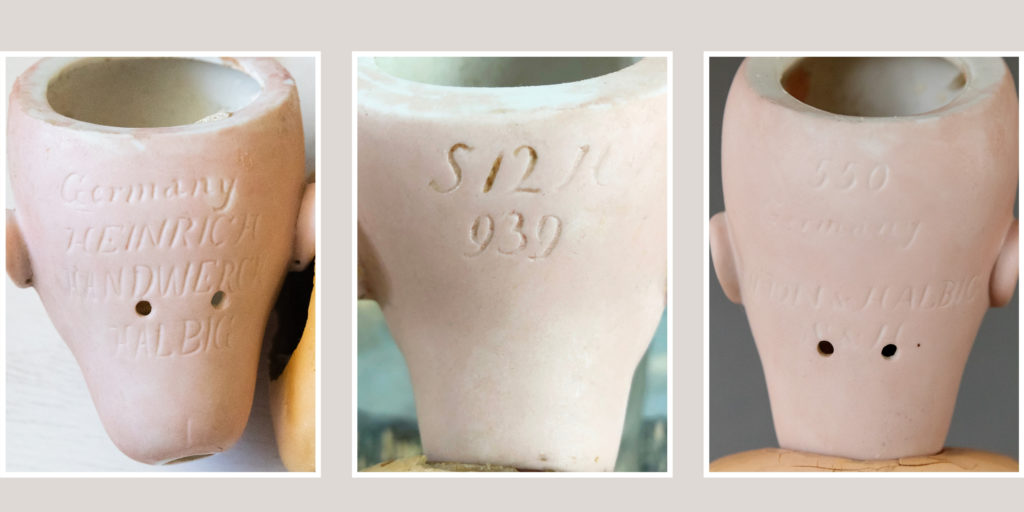


1868 Wilhelm Simon in the Jewish Community
Wilhelm Simon often donated money to the Jewish community in which he was part. In 1868 the General Journal of Judaism listed Wilhelm Simon’s donation to help distressed Israelites or Jews on the Russian border (Rabbi Dr. Ludwig Philippson, General Journal of Judaism, Leipzig 1868).
1872 Simon & Halbig’s Patent Recognized
The Duke of Coburg or the duchies of Coburg and Gotha recognize Simon and Halbig’s patent for the mechanisms invented for bathing dolls and movements of glass eyes. The acceptance was made with the understanding that the invention was new and peculiar. The notice was given on July 12, 1872 according to the Government Journal for the Duchy of Coburg of the 61st hour Wednesday July 31, 1872. Another similar announcement described the bathing doll mechanism to use rubber cords. (Sachsen-Coburg: Regierungs-Blatt für das Herzogtum Coburg. 1872)
But it seems that Simon & Halbig did not fulfill all the prerequisites for the patent for the bathing dolls to full register. For on July 17, 1875 a notice goes out that publicly cancels the patent for the rubber cord invention for bathing dolls. Doll inventors of the time faced a very competitive market. One had to do their homework.

1873 German Export Business Addresses
An 1873 address book of export businesses of the German Empire and Austria-Hungary shows Simon and Halbig’s porcelain ware factory registered in Gräfenhayn in Gotha. This German book from 1873 uses the spelling “Gräfenhayn.” Sometimes in doll reference books you see the town spelled Grafenhain. (Adressbuch der Export-Geschäfte des Deutschen Reiches und Oesterreich-Ungarns, von Leuchs & Co. in Nürnberg)
Bathing Dolls and Moving Eyes
Simon & Halbig registered a 5 year patent in July of 1873 for bisque head bathing dolls with a movement caused by an elastic cord in a new way. They also registered a patent for a moving glass eyes inside porcelain doll heads. (Verein zur Beförderung des Gewerbefleißes in Preußen / Association for the Promotion of Industry in Prussia, 1873)
1875 Simon & Halbig Registers a Trademark
In October of 1875 Simon & Halbig registered a trademark of a man sitting wearing a hat holding a tray with tea pot. They registered the mark with the local district court of Gotha, Germany. They held an address at the time for 461 Gräfenhain. (Fun note: The German Trademark Protection book gives us yet another spelling for the town: Gräfenhein.)
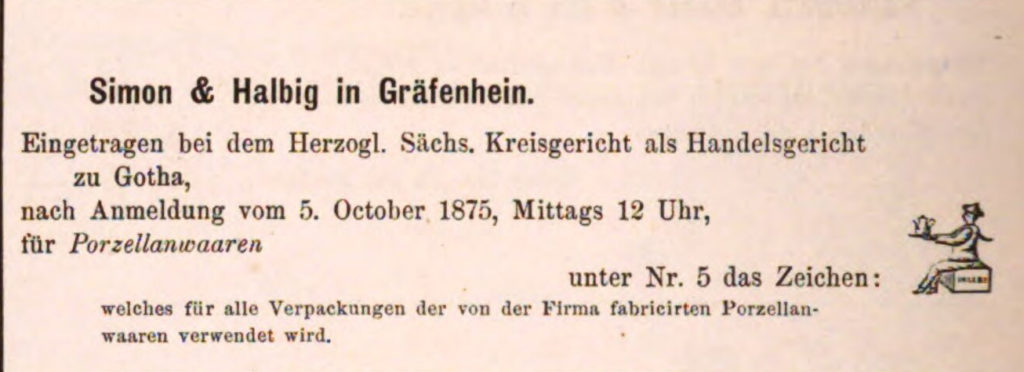
(translation) Registered with the duke. saxon District Court as Commercial Court to Gotha, after notification of October 5, 1875, noon 12 p.m., for porcelain ware under No. 5 the sign: which for all packaging of the porcelain manufactured by the company goods is used.
(Der Markenschutz: allgemeines Zeichen-Register für das Deutsche Reich (Trademark Protection), Digitale-Sammlungen.de)
Wilhelm Simon of Hildburghausen owned a factory for dolls and toys before joining with Carl Halbig. In 1875 Wilhelm Simon registered a trademark for his porcelain and toy products from Hildurgausen. The trademark depicted a boy sitting on a stool hugging a lamb registered on April 3, 1875.

1878 Simon & Halbig Listed as Doll and Toys Manufacturers
A German address book of merchants and products listed Simon and Halbig under those found in Gräfenhain near Ohrdruf. The listing says the porcelain factory offered doll heads, bathing dolls, and other children services at in the town of Hildburghausen.
1890 Patents for Moving Eyes
Simon & Halbig have a patent registered June 5, 1890 in Germany for a doll’s head with eyes that move left and right. Patent 57018 can be viewed on the German site DPMA.de here.
Another patent for moving eyelids was registered on November 1, 1890 in the Duchy of Gotha.
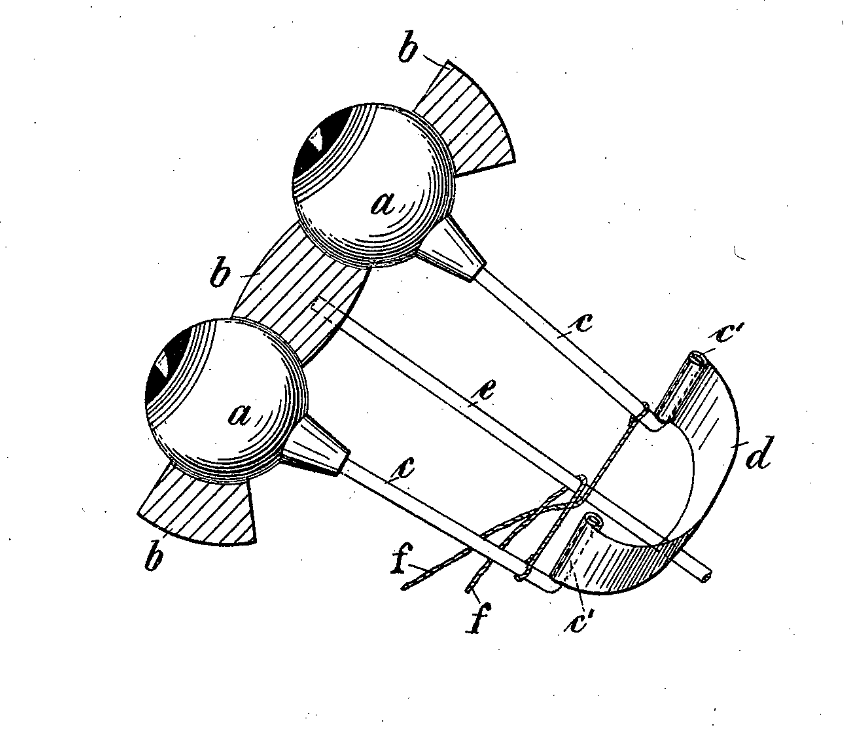
1894 Simon & Halbig Employ 220 Workers
In 1894 a Bavarian business journal (Bayerische Gewerbe-Zeitung) reported that the Coburg area of Germany had no less than 95 porcelain factories. Among those 95 factories, the Simon and Halbig factory in Gräfenhain employed 220 workers.
1895 Simon Mentioned in the Washington Journal
An American German newspaper announced in 1895 that Wilhelm Simon died at the age of 77. The newspaper described him as the head of a local trading family in Hidburghausen and the owner of one of the most important toy factories in Thuringia (Washington Journal, January 12, 1895, Page 6). Evidently Wilhelm Simon was known well enough that newspapers even as far away as Grand Island, Nebraska reported on his death.
1898 Directory of Glassware and Ceramics
In a French publication called the Directory of Glassware and Ceramics, published in 1898, Simon & Halbig appear in the chapter called JOUETS (toys) for Germany.
1900 Leipzig Fair Ad
In 1900 the Offizielles Leipziger Mess-Adressbuch (Official Leipzig Trade Fair Address Book) included a half page ad for Wilhelm Simon & Co. with the trademark of the boy sitting with the lamb. Given in German, English, and France it read (translated), “Wilhelm Simon & Co. aus Hildburghausen – LEIPZIG – Petersstr. 15, II – Fabrik gegründet im Jahre 1846. Feine Spielwaaren, Musikspielwaaren, Puppen, Porzellan, Kinderservice. Toys. Musical toys. Dolls. China sets for Children. Fine and finest styles. Jouets. Jouets à musique. Poupées. Ménages pour enfants. Genre riche.”

1903 Carl Halbig Patents
On 2 September 1903 they received the patent no. 154558 for a doll’s head with eyes connected by a joint for simultaneous movement and sitting in lateral bearings.
Carl Halbig, then the sole owner of Simon & Halbig, registers a 15 year patent on September 17, 1903 for a new eye movement mechanism. Halbig was represented by Ch. Thirion & J. Bonnet Company, in Paris, 95 Beaumarchais Boulevard (Bulletin des lois de la République Française, 1904 July 1).
Carl Halbig registered a patent for a doll head in 1905 with the United States Patent office. One can find and view the patent at the US Patent and Trademark website. Just do an advanced search for the name Halbig and he’s the earliest Halbig to show in the results. He filed the application on July 18, 1904. The patent registered on August 8, 1905 number 796,419 or document ID US-0796419-A.
The patent names him as “Carl Halbig of Gräefenhain, Germany.” (Once again, the town of Grafenhain has a new spelling.) At the beginning of the patent, Carl Halbig, states that he is a subject of the German Emperor residing at Gräefenhain, Duchy of Gotha, German Empire. Alfred Trebschuh and Arno Halbig witnessed the signing of the patent.
How the Eye Mechanism Works
The patent states that a single weight controls all the movements of the eyes inside the doll head. The eyes are movable sideways as well as vertically. This design improved past eye mechanisms that depended on more than one weight to cause different kinds of movement.
Below is a single weight eye mechanism inside a Simon & Halbig doll that has eyes that open and close as well as move to side to side. The mechanism shown here differs slightly from the drawings in the 1905 patent drawing.
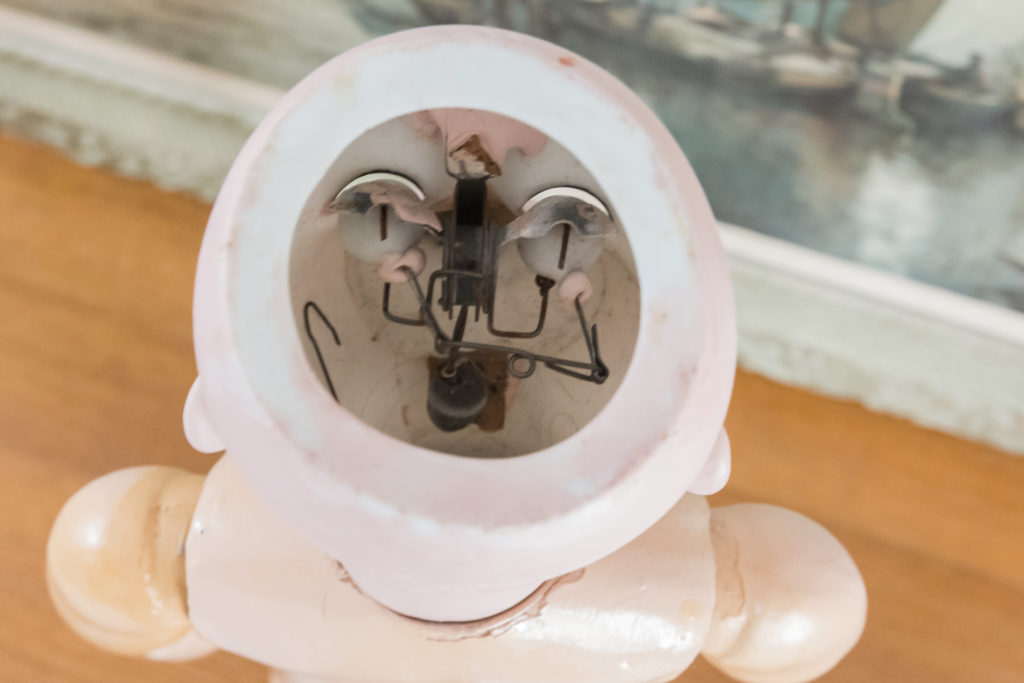

marked on the back “Simon & Halbig KR” – doll was found at auction from an estate that had transferred from New York to North Carolina
1906 German Industry Directory Listing
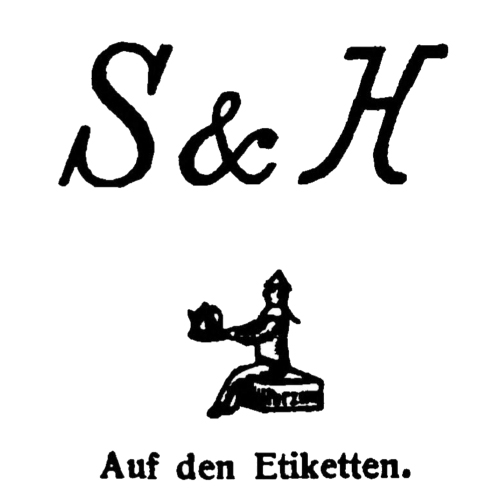
The trademark of the sitting man can also be viewed in the 1906 edition of the German industry address book, Adressbuch Der Keramischen Industrie, on page 238. In this 1906 listing the company lists Carl Halbig as owner and states that he is also the Councilor of Commerce in Gräfenhain (Duchy of Gotha).
In the listing they say they make bisque doll heads and bathing babies which were small bisque doll figurines. The doll factory employed 250 workers at the time. They also boast of their patent D.R.P. 154558 for the new eye movement mechanism allowing the eyes to move sideways or up and down. They also mention their patent D.R.G.M. patent 219510 for the eyes to move with a string pulled.
1914 Bing Company in Nuremberg
Due to the conflicts of WWI Americans stopped buying the German dolls negatively impacting many Germany doll manufacturers. The Bing Toy company in Nuremberg purchased a large portion of Simon and Halbig in 1918.
**See some other antique German doll marks here.
